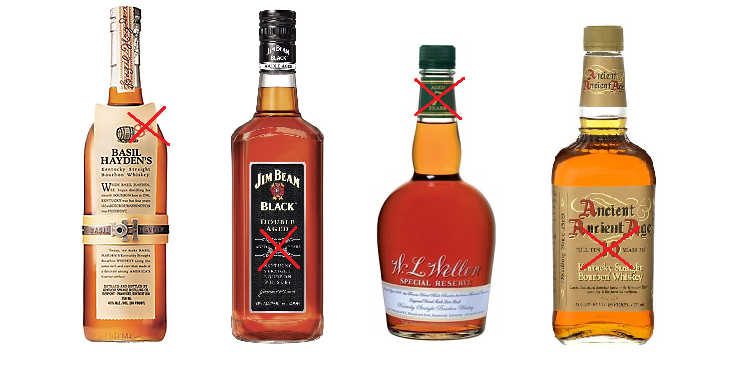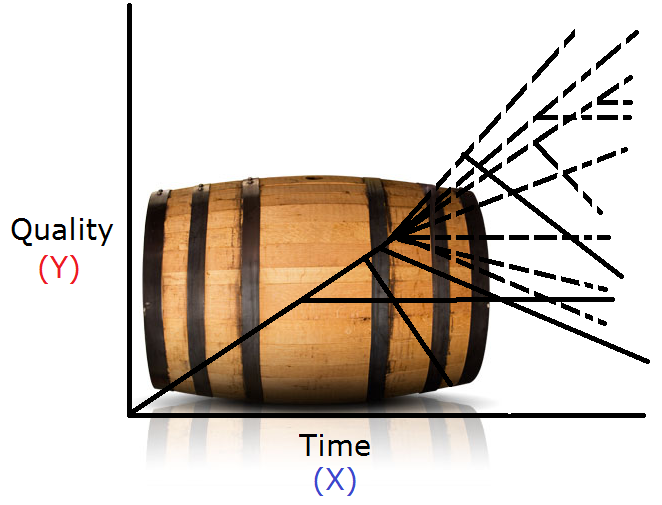Does a Bourbons Age Matter?
Is Bourbon Age Important?
There’s a lot of emphasis placed on a bourbons age. Some brands state the bourbons age on the label with pride while others, for multiple reasons, choose to leave it off. Recently, there’s been several brands that decided to drop the age statement from their labels (Grab Jim Beam Black while it still has the 8 year statement). Prices often increase with the age of a bourbon. Are older bourbons really worth more? Or, is it just more expensive to produce older bourbons and we accidentally correlate price and quality? There’s no denying age is a key ingredient in bourbon quality but it can also be a bourbons downfall. Age is the fickle beast of the bourbon process.
If you haven’t already, you may want to read our post “Bourbon Aging Explained”.
Bourbon needs time to age in charred oak barrels. That’s where a lot of a bourbons flavor and complexity come from. There have been numerous (unsuccessful) attempts from craft distillers to release bourbon younger than a couple years. One sip from one of these bottles and you’ll know immediately you’re dealing with young bourbon. What’s interesting is if you talk with any Master Distiller they’ll tell you the age of bourbon isn’t the most important important factor and a lot of times they’re only looking for a specific flavor profile and not an age. This past summer Diageo hosted a seminar “The Blind Truth About Aging Whisky” which most people discredited because they assumed it was Diageo pushing an agenda. Diageo opinions aside there is a lot of truth there.

Distilleries are dropping age statements at an all-time high (Check out Sku’s blog to see the full list). Should Bourbonr’s be worried about the new trend in bourbon to remove age statements? This is a difficult question to answer. Sure, distilleries could probably hit the same flavor profiles without being tied to a number but typically that’s not what happens. Sure, I don’t notice a big change in W.L. Weller Reserve but Ancient Age tastes a lot different after it went to “10 Star” from “10 Year”.
I had a chance to speak with Buffalo Trace Master Distiller Harlen Wheatley bourbon aging and here’s what he had to say:
B – What are some common misconceptions about a bourbons age?
H – The obvious one is that “Bourbon gets better with age.” This is generally true up until a point and that point is individually picked based on personal preference. Generally the range that most people pick is from about 5 yrs to 23+ years.
B – What other factors effect a bourbon other than time?
H – There are literally 100s of factors. Some of the biggest ones are, recipe, fermentation, distillation, wood and weather.
B – Is there a sweet spot for a bourbons age?
H – As above, the sweet spot would be determined by an individual based on their preference, however; the average age is probably 8-12 years for the sweet spot on most bourbons.
B – When does a bourbon’s flavor profile start to turn the corner from too young to good?
H – It turns the corner sooner than you think. After 6 months in the wood, bourbon is very dark and the oak is ever present. Many of the basic flavors are there and from then on it is just a matter of time to get deeper, more complex flavors from under the char layer. Officially I would say after about 4 or 5 years it is mellowed out enough for me, but again, that’s personal preference.
B – What about from good to over-oaked?
H – There really isn’t an end point because so many people love the older whiskey flavors. The end point is really a physical problem due to the evaporation of the barrel. After so many years there is literally nothing left.
B – Do you have a age range for what you like personally?
H – My range is 8-12 years for rye bourbon, and 12-15 years for wheated bourbon.
As Harlen stated, there are a lot of other factors at play in a bourbons developing flavor profile other than age. The environment a bourbon is aged in is almost as important as the duration. Take Blanton’s and Buffalo Trace for instance. They’re aged 5-6 years and 8(ish) years respectively and have similar mash bills but yet they have a much different flavor profile when tasted side by side. The difference comes from the warehouses they’re aged in. Blanton’s is aged in warehouse H which is a metal-clad warehouse and Buffalo Trace is aged in warehouse C a more traditional style warehouse. There’s no denying that the difference in flavor that comes from the different aging environments (also see my post about Weller 12 from different warehouse levels).

Are we wasting money by paying more for older bourbons? For some reason ultra-aged bourbons have become a new trend. The majority of bourbons that are left to age this long become over-oaked and require heavy filtering just to be considered “OK” bourbon however every now and then an ultra-aged bourbon comes along that is truly excellent, i.e. Parker’s Heritage #2 27 year old bourbon. Ultra-aged bourbons are more like NFL Quarterbacks in their mid-thirties. For every Brett Favre and Peyton Manning there’s thousands of other guys watching the game from their couch.
Does a bourbons age matter? The best answer I can come up with is – bourbons age is vital, until it doesn’t matter.
11 comments
http://www.hitimewine.net/JIM-BEAM-BLACK-8YR-750.html
I couldn’t agree more about the age statement from Harlen. About 8-12 for rye bourbon and I am going to push this one a bit, but 12-20 on the wheaters (Pappy 20 is incredible!). Great interview as always, Blake!
Once again, the overlying theme is…..it depends on your pallet and what you like personally. Too many people get caught up in the fan fare for ultra aged bourbons because they think, “they should like them.” If a bourbon suits you, drink it. Don’t drink it because its expensive, aged, or popular.
The only problem here is that when an employee of an outfit that’s engaged in some practice is interviewed, what do you think he’s going to say? It’ll be party line all the way. Count on it. Buffalo Trace/Sazerac has been extremely evasive and downright sneaky about what they’re up to with dropping true age statements while craftily deceiving people by leaving numbers on the labels (Old Charter 8, Barton 6, Ancient Age 10 Star) and killing Ancient Ancient Age 10 Year and Old Charter 10 Year with no notice and denying that anything was going on until the deal was done. Then there’s their ongoing price increases (often outrageous, like Weller 12 Year, Blanton’s, Eagle Rare 10 Year, E.H. Taylor and Elmer T. Lee, recently) and game-playing with allocations has gotten really tiresome. Lots of corporate b.s. going on, no? They’re the last folks that I’d go to if I wanted a straight, unvarnished story. Okay, okay – the last after Whistle Pig, Michter’s and Diageo. But that’s not really good company, is it?
I would have to agree, as a community, bourbonr’s get hung up on aged. I’ll use ‘fault’ to explain this but don’t think of the word ‘fault’ as a negative here.
Is being hung up on age the fault of the bourbonr, the community, or the marketing campaigns? It’s hard to say but I tend to believe that it’s the fault of the marketing campaigns. Marketing plays the strings of society and we, American society, live in the past; we reveal in our relics and cherish our relatively short history. As such, a smart marketing team will play off that narrative to tell a story rich in history that will sell. Every now and then you will strike oil, Farve, but the majority of the time you are left with armchair quarterbacks. When asking myself what is the best bourbon I’ve had over 15 the first thing that comes to mind is ER17; I’d be interested to see if that holds true in a blind test.
Something that is starting to change the age (history) landscape is removing the age statements and campaigns that are focused on a labor of love mentality; blood, sweat and tears type emotion. The Beam ad with Mila Kunis is a main stream example. It doesn’t invoke the nostalgic feeling but it does invoke a sense of pride in the work; another pull against American society.
(I come up with some weird stuff sometimes….most of which is fueled by bourbon.)
Fueled by bourbon at 8:42 AM? It’s time we had a talk.
All good points. As much as I don’t like to admit that marketing, packaging, etc. plays a role in taste usually blind tastings reveal the opposite.
Blake, great insight.
Remember what happened with the explosion of the wine industry? Everyone scrambled to make and sell $30-$40 cabs, merlots and pinots. We all bought it up like they were going to run out, then we put it away because it wasn’t ready yet! Then we all got used to drinking wine and more importantly we found out WHAT WE LIKED not what we were supposed to like – domaine/vintage/price be damned. Now what is being moved through the wine shops are the $8-$16 wines that are ready to drink right now and people care WAY less about vintages and whether or not it’s from this county or that region. Imbibers are getting more satisfaction from the value and drinkability.
The new whisky drinkers are being baptized by the industry and experts that push age and price over what tastes good to you and value. Drink this legendary bourbon and love it or you don’t know what you are talking about.
I believe, as the whisky popularity plateaus, there will be a market correction driven by the consumers. Most adults I know eventually grow weary of paying a lot of money for something as necessary as a good bottle of whisky.
And this is my favorite thing about consuming (coffee, wine, bourbon, meats, cigars)! You have to try LOTS of things to find what really suits you.
Never forget that these were once living things influenced by the craftsmen that cared for them and the environment they were exposed to. Find something you love and stick with it but keep trying new stuff because someone out there is making something new that will blow your mind.
Spot on. We are in the great Bourbon bubble. Sell high (if you have extras) and buy low (in 8 to 10 years) when the fakers move on and we get to enjoy all that great bourbon at discounted prices. Patience is of the essence.
Is there an annotated version of the quality v time graphic? What factors cause quality to spike with age, and which factors send it plummeting?
I suspect that not only warehouse characteristics play a significant, but also location within a warehouse. I had read in a book, probably by Chuck Cowdery, that talked about all the micro-climates in a warehouse. Because of this, 5 yrs on the ground level is nowhere near the same as 5 yrs on the top level which is also different than 5 yrs on the middle level, and all of these are different depending on if they’re next top a window with airflow or not. Which is one of the many reasons it’s absurd when people scoff at Booker’s for being a $60 bourbon that’s only 6-8 yrs old.
Really, what this probably means is that there’s not only value in age but also in warehouse location. Which makes me wonder if places like Castle & Key where other distilleries can rent warehouse space charge different rates for different locations.